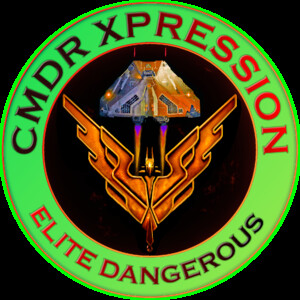Lost Souls 3 Expedition Log - 33080725
30 Jul 2022XpressioN
The Ringed Worlds
I woke up early that morning, planning to reach the next waypoint, WP16. There was a POI that I had to visit before. So I had breakfast, checked the ship, and hit the hyperjump sequence to reach 2MASS J02302948+6119446, which is part of the IC 1805 cluster. The Heart Nebula, IC 1805, Sharpless 2-190, lies some 7500 light years away from Earth and is located in the Perseus Arm of the Galaxy in the constellation Cassiopeia. This is an emission nebula showing glowing ionized hydrogen gas and darker dust lanes. The very brightest part of this nebula (the knot at the western edge) is separately classified as NGC 896, because it was the first part of this nebula to be discovered. The nebula's intense red output and its configuration are driven by the radiation emanating from a small group of stars near the nebula's center. This open cluster of stars known as Melotte 15 contains a few bright stars nearly 50 times the mass of our Sun, and many more dim stars that are only a fraction of our Sun's mass.



In the same Star Cluster is 2MASS J02351897+6131236 (Fireflies), this system is swarming with stellar objects. The high-mass O-type is in a nested binary pair with no less than three different black holes ranging from 9.4 to 31.3 solar masses. What really makes this system stand out are the five K-class stars and nine M-class stars, including one with a rare ring system. From the surface of one of the landable planets these stars will appear to flitter and fly across the sky during their orbits, giving the appearance of a field of fireflies.


Left the system for the next interesting system I had to visit. Along the way I was scanning biologicals and found a planet with a tall mountain out of nowhere. Got out my SRV and started climbing it to check out the views from up there. This reminded me of the adventures I had with my old friends back in the bubble, when we used to organise mountain climbing events.


Managed to find an undiscovered system with an atmospheric planet having the rare Recepta deltahedronix. This species of recepta produces a thick lattice of trunks in a deltahedron shape. This grows around and above the globular central organism, and helps to capture, retain and focus geothermal heat for thermosynthesis. Vista Genomics Value: 711 500 Cr. Conditions of occurrence including a planet with thin Sulfur Dioxide atmosphere, Rocky or High Metal Content planets and Maximum gravity: 0.27



Next system I visited was Phroea Phoe RD-S e4-12 (Moore-Nauenberg). This system contains a set of nine stars co-orbiting one another in a complex system of binary and trinary clusters. It is named for 20th Century physicists Cris Moore and Michael Nauenberg, who developed some of the first theoretical solutions to the 'n-body problem' -- predicting the individual motions of more than three celestial objects interacting with each other gravitationally. Measurements and detailed scans taken of this system in 3303 proved to be a tremendous boon for astrophysicists seeking to validate and refine some of Moore and Nauenberg's models. The system also features a high metal content planet orbiting a cluster of four stars and a Class V gas giant in an extremely close orbit around an Class L star.

While heading to the next POI, I found some interesting system with a planet orbiting a gas giant in close proximity. The planet had gas vents as well as geysers. Landed there and took the occasion to read some of the latest news that was happening in the Bubble. This undiscoverable system had a ringed Ammonia World and a ringed Gas Giant with Ammonia based life as well.







I then set my target to Sleguae HH-C d67 (A Heart of Gold). This Elysian Shore destination may contain the fabled 'ultimate answer' with 42 bodies. It hosts a ringed Earth-like world in a binary dance with a ringed blue gas giant. These are among a Lucky 7 of ringed planets orbiting a large Class A blue-white star. The secondary Class F white star also claims a water world and two terraforming candidate worlds in its orbit. For exobiologists, there are 12 biological signals from three planets in the system. This system boasts an awesome side view of Barnard's Loop, and is found just 2.5KLy from the Heart, Soul and NGC 7822 nebulae.


After spending a couple of hours there admiring the Earth Like World from within its rings, I then plotted a course to the waypoint of that week. Many commanders had already made it there, so I rushed a bit to meet them in time for dinner. WP16 - Slegou LU-N b21-0 (The Racetrack). The first planet of this system has an exceptionally thin ring of 231 km width. Pilots can find some fun here by racing around the ring at top supercruise speed. The ring also has a shepherd moon very close to the rings. The moon orbits the rings in 2 hours and 53 minutes, giving excellent and dynamic views. The planet itself is in a binary orbit of 7 and 1/3 hours with another planet; all three are landable and provide great views.



After spending some time exploring the system, I finally landed on one of the fleet carriers and had my ship inspected and maintained. Visited one of the bars and spent some time discussing the current situation in the Bubble. It wasn't far away. We were getting nearer to it as this expedition is coming to an end. We were also receiving distress calls from the Pleiades Sector, where the war against the Thargoids was happening.

